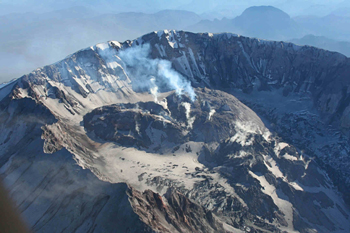New research could help predict major volcanic eruptions

Research from the Lancaster Environment Centre and University College London (UCL) is helping scientists to understand volcanic earthquakes and could give vital clues to predicting hazardous volcanic activity, such as the recent eruption in Chaiten, Chile.
Researchers know that small volcanic earthquakes occur underground in the vent feeding the magma (or molten rock) to the surface prior to many eruptions. Small earthquakes also occur within lava domes – huge, unstable mounds of highly-viscous (thick) lava that are slowly erupted at volcanoes such as Montserrat (West Indies) and Chaiten (Chile).
The research is reported in Nature 22 May http://www.nature.com/nature/journal/v453/n7194/full/nature06989.html
These earthquakes provide vital clues as to whether an eruption is imminent, or whether a slowly growing lava dome will suddenly collapse or explode. Scientists have for years been trying to understand how the earthquakes are triggered and how they relate to the state of the volcano.
Lancaster and UCL researchers have gone a step closer to being able to reliably recognise which patterns of earthquakes mean that hazardous volcanic activity is imminent.
These volcanic earthquakes have been assumed to occur in the relatively cool rocks (less than 600 degrees) surrounding moving magma, but new research published in Nature May 22, suggests that volcanic earthquakes can be generated by the fracturing of very hot, moving magma ( molten rock) itself -up to 900 degrees or even hotter.
To prove this researchers Dr Hugh Tuffen from the Lancaster Environment Centre with Rosanna Smith and Peter Sammonds from UCL, broke samples of lava in a high-temperature, high-pressure press at University College London, that can simulate the conditions inside a volcano, and attached microphones to the samples to record the micro-earthquakes that were then given off.
The surprising result confirms that fracturing of hot magma can trigger earthquakes, and the small (metre-scale) faults that scientists have recently discovered in viscous lavas, are actually fossilised volcanic earthquakes. Fracturing occurs when highly viscous silica-rich magma rises to the surface as it is too thick to flow smoothly and cracks start to form, which then develop into tiny, hot faults. Movement on these faults then triggers earthquakes and the patterns of earthquakes indicate how the magma is moving.
Dr Tuffen explained: “There has long been controversy over what causes volcanic earthquakes. Our research shows that earthquakes may be generated in rocks far hotter than previously thought. This gives us new insight into what is happening inside volcanoes when shallow earthquakes are recorded and will help us to better predict some of the most hazardous forms of volcanic activity.”
Reported in Nature 22 May , see link to the news article
http://www.nature.com/news/2008/080521/full/news.2008.849.html